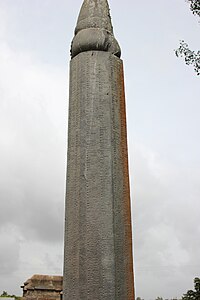Talagunda, Karnataka
History
Talagunda was earlier known as Sthanakunduru and it was an agrahara (a place of learning- ಶಿಕ್ಷಣ ಕೇಂದ್ರ). This is the earliest known agrahara found in Karnataka. Built at the time of Gouthamiputa Shathakarni (ಗೌತಮಿಪುತ್ರ ಶಾತಕರ್ಣಿ). An inscription found at Talagunda indicates that Kanchi was a major centre (ghatika) for learning, especially of the vedas taught by learned brahmanas. It indicates that 32 Brahmins were relocated from a place called Ahi-kshetra to Sthanagundur by Mukanna (or Trinetra), thereby creating an agrahara.. Mukanna was an ancestor of Mayurasharma, the founder of the Kadamba Dynasty. The word Ahi means snake or Naga in Sanskrit. Nagas were a group of ancient people who worshiped serpents. The word khsetra means region in Sanskrit. This implies that Ahi-kshetra was a region of Nagas. This could mean that the region was populated originally by Nagas, Nairs, Bunts of Kerala and Tulu Nadu who claim Kshatriya descent from the nagas trace their origins to this place.
Education was imparted at Talagunda for eight centuries and the subjects that were taught included vedas, vedanta, grammar and philosophy. The Kannada language was taught at primary level and clothing and food was provided to the students and teachers.
Inscriptions
A temple dedicated to Pranaveshwara (Hindu God Shiva) is located in Talagunda. Next to it is located a stone slab containing inscriptions. In front of it is a pillar containing inscriptions in Sanskrit. The pillar inscriptions were written in the mid 5th century CE during the reign of Śāntivarman (a descendant of Mayurasharma). The author of this inscription was Kubja, the court-poet of Śāntivarman. He engraved the inscriptions himself to prevent any other engraver from committing mistakes.

Kubja, describes these inscriptions as a kavya thus:
In deference to the command of King Santivarman,
Kubja has written this, his own kavya,
upon the face of this rock
The inscriptions indicate that Mayurasharma, native of Talagunda, was accomplished in vaidika and went to the Pallava capital, Kanchipuram to study scriptures, accompanied by his guru and grandfather Veerasharama. There, having been humiliated by a Pallava guard (horseman), in a rage Mayurasharma gave up his Brahminic studies and took to the sword to avenge his insult. The inscription vividly describes the event thus:
That the hand dextrous in grasping the kusha grass, fuel and stones, ladle, melted butter and the oblation vessel, unsheathed a flaming sword, eager to conquer the earth
The inscriptions thus describe Kadambas as Brahmins turned conquerors and praise Brahmins as "Gods on earth, and speakers of Sama, Rig and Yajur Vedas". The Kadamba lineage is described as descending from a three-sage line in the Hariti pravara and belonging to the Manavya gothra.

Notes
- ^ Dr. Jyotsna Kamat (21 December 2007). "The Kadambas of Banavasi". Retrieved 1 May 2008.
- ^ B. L. Rice, p482
- ^ Dr. Jyotsna Kamat (20 December 2007). "The History of Agraharas". Retrieved 1 May 2008.
- ^ Maclean's Manual of the Administration of the Madras Presidency
- ^ F. Kielhorn, ‘Talagunda Pillar Inscription of Kakusthavarman’, EI 8 (1905-06): 31-33 (inscr); Sheldon Pollock, [incomplete reference], p. 116.
- ^ D. C. Sircar, p. 86
- ^ Sheldon Pollock, p135
- ^ Kamath (2001), pp. 30–31
- ^ Ramesh (1984), p6
- ^ Kamath (2001), p31
- ^ Moraes (1931), p15
- ^ Federico Squarcini, p98
References
- Rice, B. Lewis (2001). Gazetteer of Mysore. Asian Educational Services. ISBN 81-206-0977-8.
- Pollock, Sheldon I. (2006). The Language of the Gods in the World of Men: Sanskrit, Culture, and Power in Premodern India. University of California Press. ISBN 0-520-24500-8.
- Sircar, D. C. (1996). Indian epigraphy. Motilal Banarsidass Publications. ISBN 81-208-1166-6.
- Moraes, George M. (1996) [1931]. The Kadamba Kula, A History of Ancient and Medieval Karnataka. Asian Educational Services. ISBN 81-206-0595-0.
- Ramesh, K.V. (1984). Chalukyas of Vatapi. Agam Kala Prakashan. OCLC 13869730.
- Squarcini, Federico (2005). Boundaries, Dynamics and Construction of Traditions in South Asia. Firenze University Press. ISBN 88-8453-262-0.
- Kamat, Suryanath (2001) [1980]. A Concise history of Karnataka from pre-historic times to the present. Jupiter. OCLC 7796041.